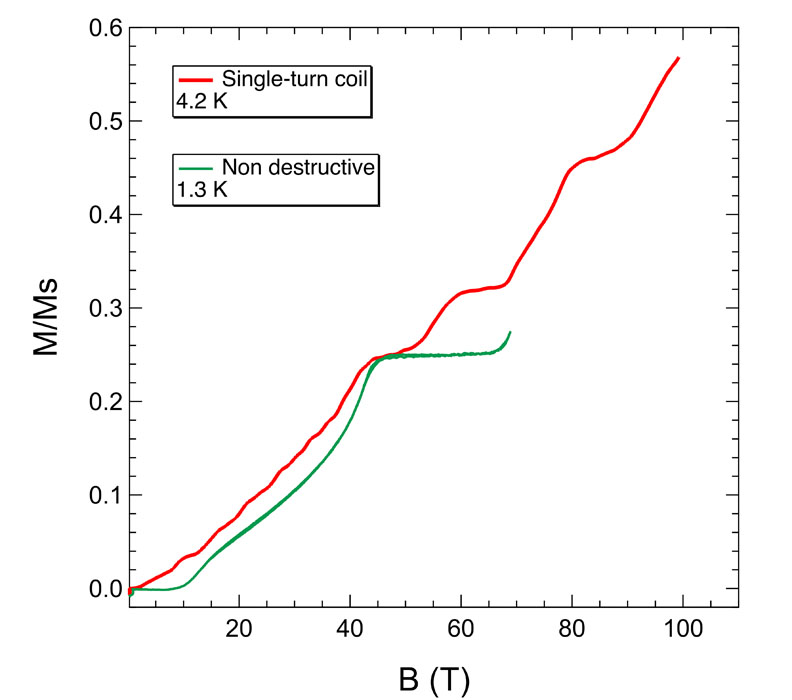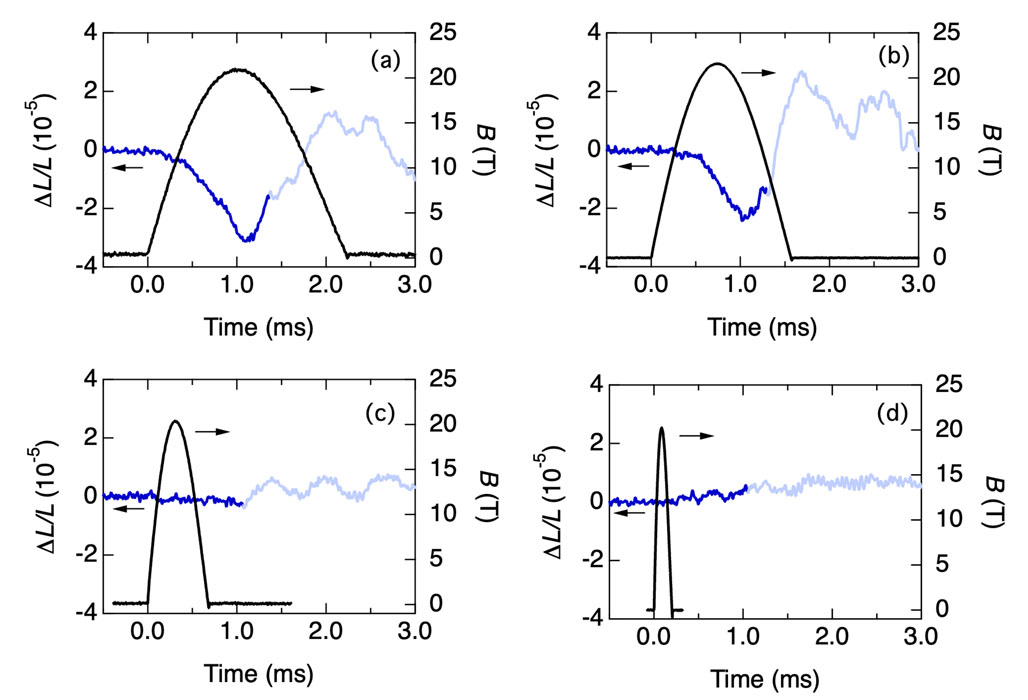Metastable Quantum Phase in Adiabatic Condition with the Spin-Lattice Separation
Y. H. Matsuda, Kohama, and Kindo Group
Several low-dimensional spin systems exhibit exotic magnetization processes such as magnetization plateaux as a result of the appearance of exotic quantum phases. The spin-ladder materials are intriguing because they possess intermediate properties between one- and two-dimensions. The two-leg spin-ladder compound 3, 3′, 5, 5′-tetrakis(N- tert-butylaminoxyl)biphenyl: C28H42N4O4 (BIP-TENO) was synthesized as the first S = 1 two-leg spin ladder, where S is the spin quantum number. In BIP-TENO, the nontrivial 1/4 magnetization plateau was observed in the magnetic field range from 42 to 66 T and theoretically analyzed [1]. To explain the 1/4 plateau, the authors of Ref. [1] introduced the second-nearest-neighbor (diagonal direction) and third-nearest-neighbor (leg direction) exchange interactions and found that the third-nearest-neighbor exchange interaction is more essential for the appearance of the 1/4 plateau. They obtained the magnetization by a numerical diagonalization. Although further successive phase transitions to the 1/2 and 3/4 plateau states are theoretically predicted [1], they were never experimentally observed because the required magnetic field is as strong as 150 T, which is only available employing a destructive manner [2]. In the present study, the entire magnetization process of BIP-TENO is investigated in ultrahigh magnetic fields of up to 150 T using the single-turn coil that is one of the destructive means for ultrahigh magnetic field generation. It is unveiled that 1/3 and 2/3 plateaus appear in addition to the previously discussed 1/4, 1/2, and 3/4 plateaus. Moreover, the 1/3 and 2/3 plateaus are found to appear only when the magnetic field is swept in a microsecond timescale. The adiabatic condition is likely to be necessary for its observation, suggesting that the newly observed plateaus are metastable states.
The single crystals of BIP-TENO were used. The typical dimensions of the crystal used are 2 ~ 4 × 0.5 × 0.2 mm3 and the direction of the long side is parallel to the c-axis. Three or four single crystals were used for the magnetization measurement to obtain the larger signal. In the pulsed-field experiments, magnetic fields (B) were applied parallel to the c-axis of the crystal that is parallel to the leg direction of the spin ladder. The ultrahigh magnetic fields were generated using the single-turn coil. The magnetization was measured using a self-compensated parallel-type pickup coil. The sample temperature was lowered by directly immersing the sample in liquid helium or by putting the sample in flowing cold helium gas.
Figure 1 shows the magnetization process measured at 4.2 K with the single-turn coil up to approximately 100 T (a red curve) [3]. The pulse duration is about 7 μs. In the figure, the previously reported magnetization curve at 1.3 K [1] is also shown for comparison (a green curve). A nondestructive magnet with a 5 ms duration was used in this measurement.
The 1/4 plateau is observed in both (red and green) curves. The striking difference is seen in the length of the plateau: the plateau ends at around 50 T and a new plateau appears after that in the red curve, while it continues to around 70 T. One may wonder whether this distinct difference can be caused by the temperature difference because the fast magnetic field changes potentially induce the temperature change due to the magnetocaloric effect. Hence, we investigated the magneto-caloric effect and found that although temperature decreases by several degrees with increasing the magnetic field in adiabatic conditions, the plateau lasts at least up to 60 T and no new plateau emerges at around 50 T [3]. This fact excludes the possibility that the different temperatures cause the different magnetization processes.
The measurement of the magnetostriction solved this mysterious question. We found that the leg direction of the crystal shrinks when the spin gap closes. The fiber Bragg grating method was utilized. The shrinkage of the lattice also causes a dissipation process and causes some heat production, which was detected in our magnetocaloric effect.
Figure 2 shows the shrinkage of the lattice when a pulsed magnetic field is applied as a function of time [3]. The lattice shrinks when a magnetic field is applied slowly (Fig. 2 (a)). However, the response of the lattice is delayed for the shorter field pulse (Fig. 2 (b)), and then, interestingly, the lattice doesn’t move if the magnetic field pulse is short enough (Fig. 2 (c.) (d)). The threshold time is around 1 ms, which gives the answer to why the two different magnetization processes are observed with fast and slow magnetic field pulses.
The red curve in Fig. 1 is a magnetization process for the spins at the original lattice sites. The length of the 1/4 plateau suggests the strength of the interaction given by the zero-field crystal lattice. The new plateau following the 1/4 plateau seems to be assigned to the 1/3 plateau which has been proposed to emerge in a recent theoretical study [4]. The longer 1/4 plateau seen in the green curve in Fig. 1 is explained by an enhancement in the exchange interaction along the leg direction due to the contraction of the leg direction by a magnetic field.
In summary, the slow contraction of the crystal in the leg direction by the application of a magnetic field stabilizes the 1/4 plateau and hinders the following 1/3 plateau. The novel 1/3 plateau is a metastable state where the crystal lattice maintains the original form within a short time in the range of microseconds. This metastable quantum phase is a result of the spin-lattice separation and has hardly ever been observed before.
References
- [1] T. Sakai, N. Okazaki, K. Okamoto, K. Kindo, Y. Narumi, Y. Hosokoshi, K. Kato, K. Inoue, and T. Goto, Phys. B: Condens. Matter 329, 1203 (2003).
- [2] N. Miura, T. Osada, and S. Takeyama, J. Low Temp. Phys. 133, 139 (2003).
- [3] K. Nomura, Y. H. Matsuda, A. Ikeda, Y. Kohama, H. Tsuda, N. Amaya, T. Ono, and Y. Hosokoshi, Phys. Rev. B 105, 214430 (2022).
- [4] H. Kohshiro, R. Kaneko, S. Morita, H. Katsura, and N. Kawashima, Phys. Rev. B 104, 214409 (2021).


